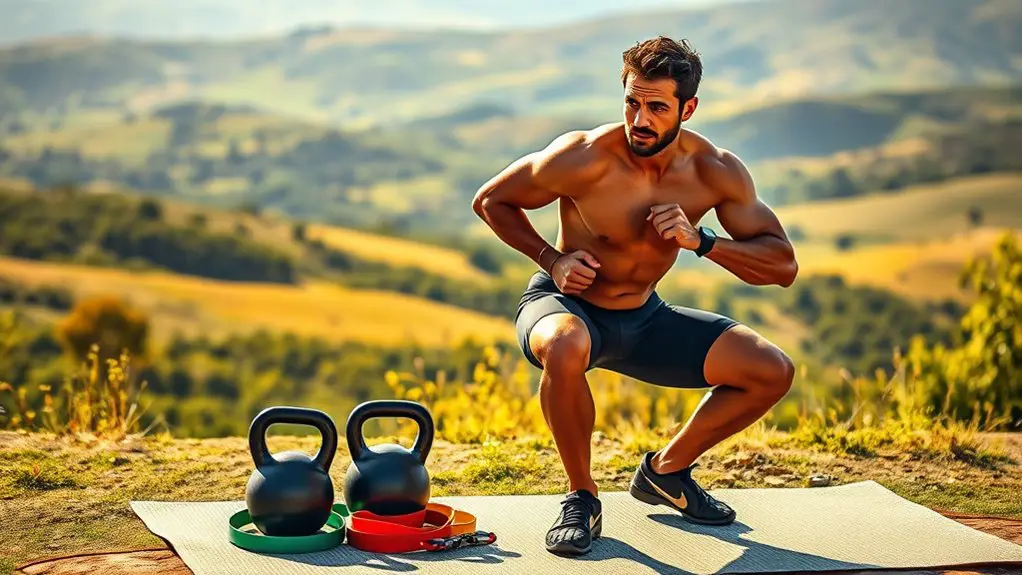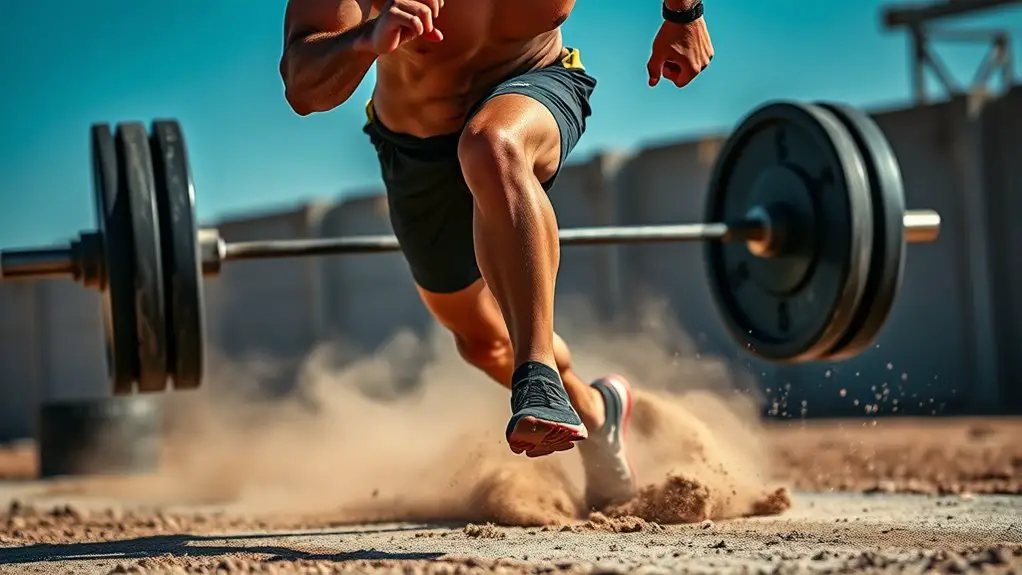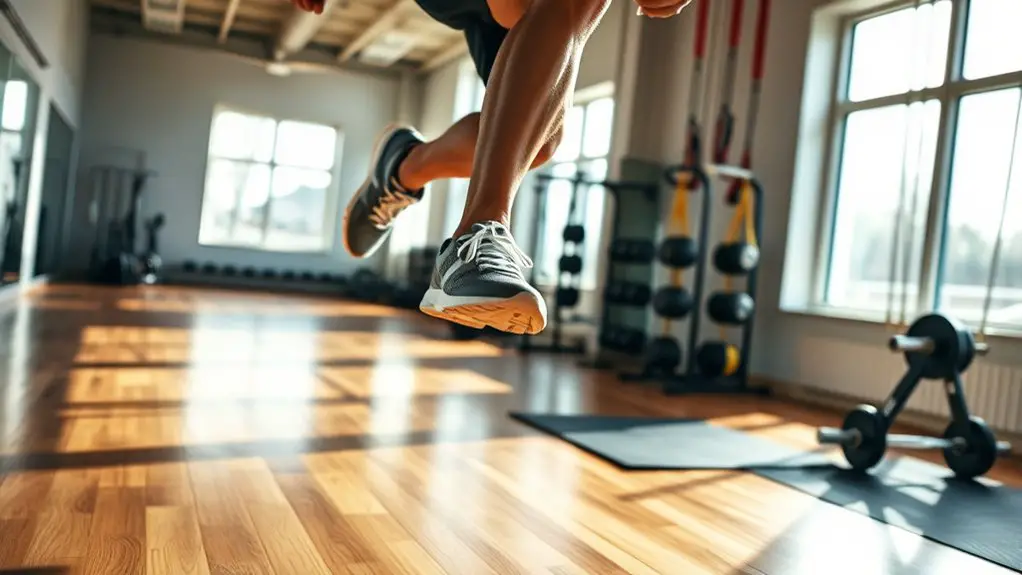To boost your cycling performance, focus on leg-strengthening workouts like squats and lunges. Squats enhance stability and power in your pedal strokes, while lunges improve balance and core engagement. Incorporating resistance training with bands can target key muscle groups, and plyometric exercises add explosiveness for quicker acceleration. Don't forget core workouts to support your legs and maintain proper form. Keep going to discover more effective ways to elevate your cycling strength and performance.
Squats: Building Strength and Stability
When you incorporate squats into your training routine, you'll not only enhance your leg strength but also improve your overall stability on the bike. Squats help develop the muscles that power your pedals, giving you the freedom to conquer any terrain. To make the most of your workouts, explore squat variations like goblet squats or single-leg squats. Each variation targets different muscle groups, so mix them up for balanced strength. Additionally, incorporating full-body strength exercises can further enhance your overall power and stability while cycling.
Lunges: Enhancing Balance and Power
Lunges are a fantastic way to enhance your balance and power on the bike. They're not just about strength; they engage your core, improving stability while you ride. Incorporating lunge variations into your routine can elevate your biking experience and freedom on the road. Additionally, prioritizing mobility training can help ensure you maintain the range of motion necessary for optimal performance.
Here's a quick overview of effective lunge variations:
| Lunge Variation | Focus Area | Benefits |
|---|---|---|
| Forward Lunge | Quads & Glutes | Builds strength and power |
| Reverse Lunge | Hamstrings & Glutes | Enhances balance and stability |
| Side Lunge | Inner Thighs | Improves lateral strength |
| Walking Lunge | Overall Leg Strength | Boosts endurance |
| Curtsy Lunge | Glutes & Core | Enhances hip flexibility |
Integrating these balance exercises into your training will reveal new levels of performance and confidence on your bike. Embrace the freedom that comes from being strong and stable!
Resistance Training: Targeting Key Muscle Groups
Building on the balance and power gained from lunges, resistance training can further enhance your cycling performance by targeting key muscle groups. Using resistance bands is a fantastic way to build strength while maintaining mobility. These bands allow you to engage your quadriceps, hamstrings, and glutes, vital for powerful pedal strokes.
Incorporating exercises like banded squats or leg presses into your routine not only boosts muscle endurance but also increases your overall stability on the bike. You'll feel the difference during long rides, as stronger legs can handle varying terrain with ease. Proper nutrition during your training is essential to support this strength-building process.
Don't forget to mix in upper body resistance training too, as it supports your posture and control while cycling. By focusing on these essential muscle groups, you'll gain the freedom to ride longer and stronger, enjoying every moment on the open road or trail. Embrace the challenge, and watch your cycling performance soar!
Plyometrics: Boosting Explosiveness
Plyometrics can elevate your cycling game by enhancing your explosiveness, allowing for quicker acceleration and powerful bursts of speed. Incorporating jump drills into your routine can reveal your potential and give you that freedom on the bike you crave. Here are four effective exercises to get you started:
- Box Jumps: Leap onto a sturdy surface, focusing on landing softly to build strength and coordination.
- Broad Jumps: Propel yourself forward as far as you can, using your arms for momentum, which mimics the powerful push-off needed in cycling.
- Lateral Bounds: Jump side-to-side to enhance your lateral strength, improving stability on the bike.
- Depth Jumps: Step off a platform and immediately jump upon landing for a powerful explosive movement.
Integrating these exercises into your training can greatly boost your cycling performance, giving you that extra edge when you need it most. Additionally, focusing on functional strength through these plyometric exercises can enhance your overall power output on the bike.
Core Workouts: Supporting Leg Performance
While you might focus on leg strength for cycling, don't underestimate the importance of a strong core. Your core plays a critical role in providing the stability and endurance you need for those long rides. When your core is strong, it supports your legs and helps maintain proper form, allowing you to pedal efficiently and powerfully.
Incorporate exercises like planks, Russian twists, and bicycle crunches into your routine to boost your core stability and endurance. These workouts not only enhance your balance but also reduce the risk of injury, giving you the freedom to ride longer and harder. Additionally, don't overlook the significance of glute activation as it plays a crucial role in enhancing performance and preventing injuries.
Don't forget about dynamic movements like mountain climbers or stability ball rollouts; they add an element of challenge while engaging your entire core. By committing to core workouts, you'll find that your legs perform better, and you can conquer those hills with confidence.
Frequently Asked Questions
How Often Should I Incorporate Leg-Strengthening Workouts Into My Cycling Routine?
To get the most out of your cycling routine, you should aim to incorporate leg-strengthening workouts into your weekly schedule about two to three times. This workout frequency allows your muscles to recover while building strength. Listen to your body; if you feel fatigued, adjust accordingly. You want your training to feel freeing and enjoyable, so don't hesitate to mix it up and find what works best for you!
Can Leg-Strengthening Workouts Prevent Cycling Injuries?
Imagine your legs as the sturdy roots of a tree, anchoring you firmly as you ride. Leg-strengthening workouts aren't just about building muscle endurance; they're your shield against injury. By incorporating these exercises, you enhance your body's resilience, allowing you to cycle longer and more freely. Stronger legs help absorb the impact of each pedal stroke, reducing wear and tear, and ultimately, keeping you on the road to adventure.
What Is the Best Time of Day for Leg Workouts?
When it comes to ideal workout timing for leg workouts, it really depends on your schedule and when you feel most energized. Some folks swear by morning workouts, claiming it kickstarts their day. Others find evening sessions more effective, as they've had time to fuel up. Ultimately, you should choose a time that fits your lifestyle and allows you to push yourself. Listen to your body, and go with what feels right for you!
Do I Need Special Equipment for These Leg Workouts?
Imagine your legs as a sturdy tree, rooted yet flexible. You don't need fancy equipment to nurture that strength; bodyweight exercises can sculpt your muscles beautifully. Think squats and lunges that let you feel free as a breeze. If you want to add a challenge, resistance bands can offer just the right resistance without the need for weights. So, grab what you have, and let your legs flourish in their own space!
How Can I Track My Progress in Leg Strength?
To track your progress in leg strength, start by setting clear strength benchmarks. You can measure metrics like the weight you lift or the number of reps you complete. Keep a workout journal or use fitness apps to log your workouts and note improvements over time. Additionally, consider incorporating functional movements that mimic your goals. By regularly evaluating these progress metrics, you'll feel more in control of your journey toward stronger legs.




